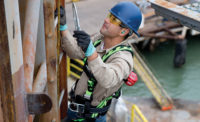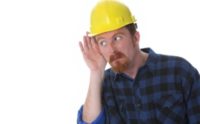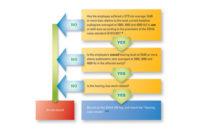When it comes to the growing volume of regulations and standards currently “in the works” around the world, it’s best to heed that old maxim: “forewarned is forearmed.” While we’re not ready to take action on any of these updates, it’s a good idea to at least get ready to do so.
To start, let’s clarify briefly the difference between regulations and standards. Standards are specific requirements, often taking the form of guidelines, developed by private industry groups, such as the American National Standards Institute (ANSI) or the Canadian Standards Association (CSA), but which do not have the force of law.
Regulations are rules or orders promulgated by a governmental body pursuant to legislative authority, and have the force of law. Examples of government authorities include OSHA and the U.S. Environmental Protection Agency (EPA). Regulations may rely on standards to describe, define, or clarify certain requirements.
| Hearing Conservation regulations | ||
| U.S | Canada | Europe |
Current activities: In the U.S.
In the United States, hearing conservation regulations are promulgated by governmental authorities such as OSHA, the Mine Safety and Health Administration (MSHA), and other agencies, depending on jurisdiction. Although these agencies continue to enforce current regulations — and inspectors are currently emphasizing noise as a hazard — there is very little chance of regulatory changes in the near future. There are many reasons for this, including the current political and financial climate.
One hearing conservation-related regulation pending is under the authority of the EPA. The EPA is responsible for the labeling requirements for hearing protection devices (HPDs) that hearing protection manufacturers must meet. In 2009 the EPA announced a proposed new regulation for the testing and labeling of hearing protectors. For a summary of that proposal, see http://hearforever.org/learn/regulations.
The regulatory process often moves at what seems like glacial speeds. After extensive public comment, the proposal has been revised and is still under review within the EPA. However, given the number of high-priority rules slated for review, it may take a while for the new labeling rule to make it through the process. After the rule clears the EPA, it then goes to the Office of Management and Budget (OMB) for review, which is a 90-day process (but sometimes can take longer).
The Acoustical Society of America (ASA) provides the Secretariat for Accredited Standards Committees S1 on Acoustics, S2 on Mechanical Vibration and Shock, S3 on Bioacoustics, S3/SC 1 on Animal Bioacoustics, and S12 on Noise. These committees have wide representation from the technical community (manufacturers, consumers, trade associations, organizations with a general interest and government representatives). The standards are published by the Acoustical Society of America as American National Standards after approval by the applicable Standards Committees and by ANSI.
Within each of the Standards Committees are several active Working Groups. One in particular is of interest because of the new topic of fit-testing hearing protection. Standards Committee S12 (Noise), Working Group 11, is currently drafting a standard on individual field fit-testing of hearing protection, with the working title Performance Criteria for Systems Designed to Estimate the Attenuation Obtained by Individual Users of Passive Hearing Protectors.
This new standard pertains to systems intended to estimate the protection or attenuation obtained by individual wearers of HPDs in actual practice. The standard coins the term “field attenuation estimation systems” (FAES) to refer to the systems that can be used to determine attenuation of hearing protection in real-world environments as opposed to equipment used strictly in laboratory environments. This standard classifies different FAES methods and specifies minimum performance criteria they will be required to meet.
In Canada
In Canada, the CSA functions through Technical Committees such as the Occupational Hearing Conservation Technical Committee (S.304). Sub-committees have been actively working to expand and update Canadian standards for the past couple years.
A new standard for Hearing Conservation Program Management (Z.1007) is envisioned to be a unique, “over-arching” document that will be used by non-technical professionals who have the responsibility to protect Canadian workers from noise hazards. The new standard will focus on “what” to do to have an effective hearing conservation program and will reference other existing and new documents that focus on “how” to accomplish various requirements. Reference documents include:
CAN/CSA-Z94.2-02 (R2011) - Hearing Protection Devices - Performance, Selection, Care, and Use (published in 2002 and reaffirmed in 2011)
CAN/CSA-Z107.56-06 (R2011) - Procedures for the Measurement of Occupational Noise Exposure (published in 2006 and reaffirmed in 2011)
CAN/CSA-Z107.58-02 (R2008) - Noise Emission Declarations for Machinery (published 2002 and reaffirmed 2008).
These documents do not have the force of law but serve as guidelines based on current consensus of experts in the field.
In Canada each province/jurisdiction has its own hearing conservation regulation which often references CSA Standards.
In Europe
In the European Union, NA 075 (Personal Protective Equipment Standards) is the consensus standards body. It works on national, European and international standardization matters regarding personal protective equipment (PPE) for head protection, hearing protection and protection against falls from height.
The European Parliament defines workplace safety directives to which EU member states must comply. One of the most significant changes in hearing conservation regulations occurred in 2006 when Directive 2003/10/EC went into effect, establishing new values for allowable noise exposures.
The Lower Action Level for noise was reduced from 85 dB to a more-protective 80 dB. For exposures above this level, hearing protectors and training must be made available, and audiometric screening is provided to noise-exposed workers.
The Upper Action Level for noise was also reduced, from 90 dB to a more protective 85 dB. At this level, use of hearing protectors is required, and warning signs must be posted. Although a 5 dB change in allowable noise exposures may seem quite minor, research indicates these more protective levels may reduce the risk of noise-induced hearing loss by nearly 20 percent in noise-exposed populations. These action levels are much more protective than equivalent U.S. levels, which allow unprotected noise exposures up to 90 dB for an eight-hour workday.
In addition, the EU Directive established an exposure limit of 87 dB as the maximum allowable daily noise exposure, under the hearing protectors. This means employers must now ensure that suitable hearing protectors are selected and fitted to ensure the noise level reaching the eardrum is below 87 dB.
A number of employers are using fit-testing of hearing protectors to verify this in-ear exposure, and some EU member states are implementing regulations to require regular fit-testing of some types of earplugs.
One interesting aspect of the EU Directive was its inclusion of workers in the music and entertainment industries (noisy clubs, concert venues, performance stages, etc.). Although compliance with noise regulations is largely overlooked in the entertainment segment in the U.S., the European regulations specifically call out the music and entertainment industries for inclusion in the new action levels. A monumental education effort is helping to make club and concert workers aware of the hazards of noise, and the steps for preventing music-induced hearing loss.
In Germany and France, it is now highly recommended to fit-test custom hearing protection. There are also efforts to move hearing protection to a different category of PPE which would require fit-testing. That is an exciting development. Individual fit-testing for all types of earplugs allows better selection, training, and use of earplugs, and any step toward that goal is laudable.
Get ready & get involved
Keep up to date with regulatory changes as they are made public. If you have pertinent data that might be used by the committees and working groups as evidence to support changes (or the status quo), share that information. One route to take to get information to any of those standards bodies is via a professional organization such as the National Hearing Conservation Association (NHCA). Despite the name, NHCA is an international organization and can help connect you with the members of these working level committees.



